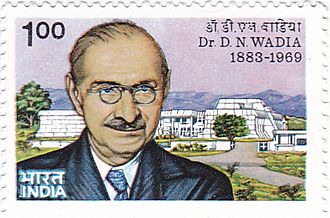Darashaw Nosherwan Wadia facts for kids
Darashaw Nosherwan Wadia (born October 23, 1883 – died June 15, 1969) was a very important geologist in India. He was one of the first Indian scientists to work for the Geological Survey of India. People remember him for his studies on the rock layers (called stratigraphy) of the Himalayas. He helped start geological studies in India, especially at the Institute of Himalayan Geology. This institute was later renamed the Wadia Institute of Himalayan Geology in his honor in 1976. His famous book, Geology of India, first published in 1919, is still used today.
Contents
Early Life and Education
Wadia was born in Surat, India, on October 23, 1883. He was one of nine children in a Parsi family. His family had a history of shipbuilding. His father worked for the Indian Railways.
Young Wadia went to school in Surat and then in Baroda. His older brother, Munchershaw N. Wadia, who was an educationist, helped him become interested in science. At age 16, Wadia went to Baroda College. He studied botany and zoology, earning a science degree in 1903. He then earned another science degree in botany and geology in 1905. In 1905, he also got a master's degree in biology and geology and started teaching.
At that time, not many places in India taught geology. In 1906, when he was 23, Wadia became a Professor of Geology at the Prince of Wales College in Jammu. He taught there for 14 years.
Work in Jammu
The college in Jammu supported Wadia's work. Its location also allowed him to study the geology of the nearby areas. During his holidays, he explored the Himalayan region, collecting rocks and fossils.
In 1919, he published his textbook, Geology of India. This was the first new geology textbook for Indian students in a long time. Many new versions of this book were printed over the years, and it is still a key book for studying Indian geology. In 1925, he found tusks and bones from an ancient elephant-like animal called Stegodon ganesa.
Joining the Geological Survey of India
In 1920, the Geological Survey of India (GSI) grew bigger. In 1921, Wadia was offered a job there. He was 37 years old. He was not the first Indian to join the GSI, but he was the first who did not get his degree from a European university.
His first work at the GSI was studying the geology of the Himalayas. This involved careful fieldwork and mapping. He collected many ancient sea creatures called trilobites. He also found old plant fossils and tiny sea creatures called Foraminifera. These discoveries helped improve the geological maps of the region.
Wadia became the Paleontologist (a scientist who studies fossils) at the GSI in 1928. He stayed in this role until 1935. When he left the GSI in 1938, he held the same rank he started with, Assistant Superintendent.
Work in Ceylon (Sri Lanka)
After leaving the GSI in 1938, Wadia took a job with the government of Ceylon (now Sri Lanka). He worked as a Mineralogist, studying the minerals and rocks of the island.
Return to India and Later Contributions
Wadia came back to India in 1945. In 1947, he became an advisor to the Indian government, led by Prime Minister Jawaharlal Nehru. He suggested that India should focus more on science and get scientists to work together. He believed this would help India use its natural resources like land, rivers, forests, and minerals.
In 1949, he was asked to help find raw materials for atomic energy. This led to the discovery of important minerals like thorium and uranium in different parts of India, including Kerala, Bihar, and Rajasthan.
Wadia also studied the layers of rocks in the Himalayas. He worked to figure out how old different parts of the mountains were and how they formed. He also studied fossils from the Siwalik Hills.
He was interested in how the Earth's crust moves and changes. He also studied soil science. In 1954, he suggested that the Ice Age in the northern parts of the world was a time of heavy rainfall in warmer, tropical areas. One of his early ideas was to explain the sharp bend in the mountain ranges around Nanga Parbat.
Awards and Honors
Wadia received many awards for his important work.
- In 1934, he received the Back Award from the Royal Geographical Society.
- In 1943, he received the Lyell Medal from the Geological Society of London.
- He also received medals from Indian scientific groups.
- In 1958, the Indian government gave him the Padma Bhushan, one of India's highest civilian awards.
- In 1957, he was elected a Fellow of the Royal Society, a very respected scientific group in the UK.
In 1984, India released a postage stamp with Wadia's picture on it to honor him.
Images for kids


